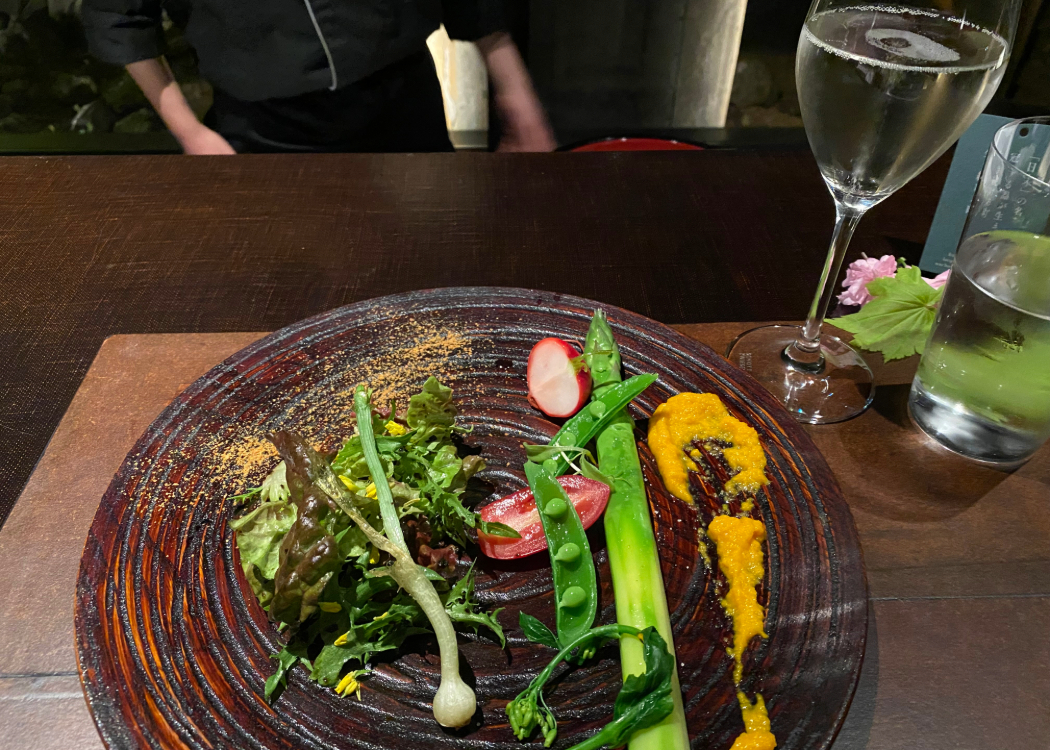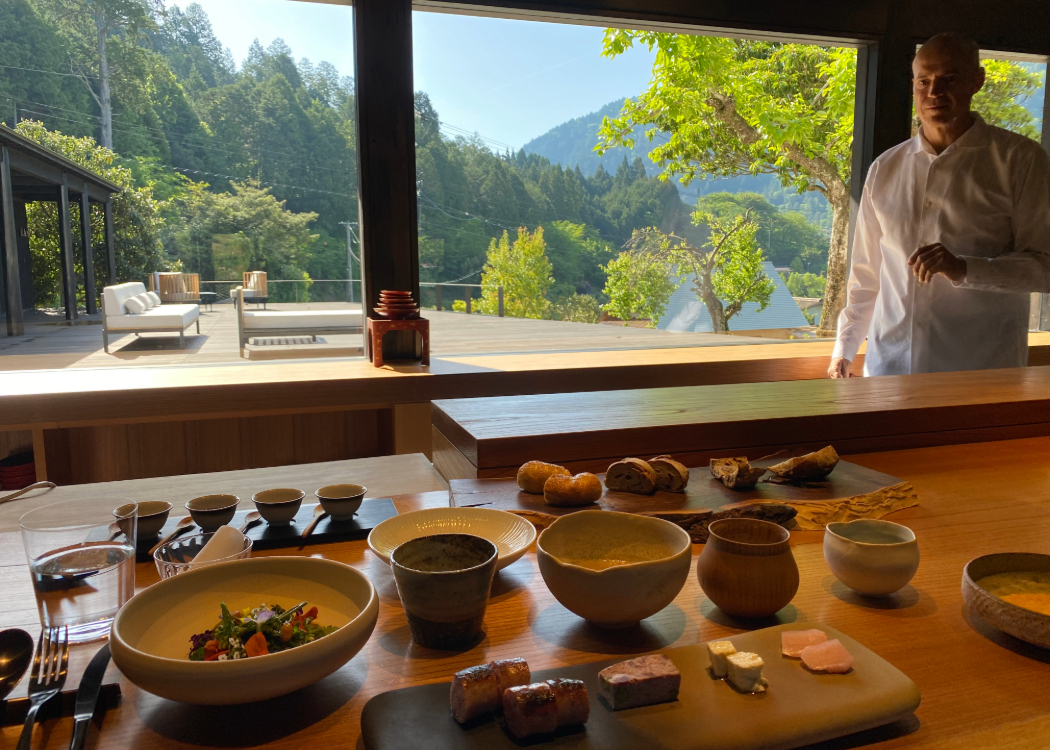Japan is known for its cuisine, which showcases local seafood, vegetables and farm produce, freshly made soba and buckwheat noodles, and a variety of cooking and serving styles. Our Japan dining guide covers popular dining options you can expect to see in hotel restaurant menus, and the finer food and beverage tips we think will help you have a great first-time experience in Japan.
Dinner options in Japan
Here are some of the common dining options you will encounter in Japan –
- Kaiseki is a popular set menu dining option featured at Japan’s best hotels and ryokans. It's a multi-course affair featuring beautifully presented small dishes showcasing seasonal produce. The courses typically include sashimi and sushi, grilled fish, pickled vegetables and accompaniments, hot pot dishes - such as chicken and vegetables in broth, rice and/or noodle dishes, miso soup, and a sweet course to finish. Local grilled meat - such as wagyu beef - might also be featured. The Kaiseki experience is a feast for the eyes and as much about the artistic expression on the plate, as the taste.
- Ryori is a form of kaiseki, featuring only vegetarian items. You will enjoy Japanese Ryori cuisine when visiting Buddhist temple lodges (Shukubo) in villages like Koyasan.
- Teppanyaki is a unique dining experience where you sit at a bar counter or table overlooking a large grill plate watching the expert chef prepare your meal. Several small courses are served, cooked one after the other, so you can dine on each course as it is prepared. To become a Teppanyaki chef, it takes about 10 years of expert training, so these are master craftsman who you will love watching as they use special Japanese knives and the grill to prepare your meal. One of our favourite Teppanyaki experiences is at Fufu Nara.
- Sashimi and sushi – A very popular dining option in Japan, sashimi and sushi is commonly served in most Japanese restaurants. Sashimi refers to thinly sliced raw fish – such as kingfish, tuna, salmon, varieties of river-fish or even squid. Sushi is made with vinegared rice and combined with fresh ingredients like raw (or sometimes cooked) fish or vegetables, wrapped in seaweed. Both are part of the Kaiseki experience, served at the start of the meal. This is great news for those of us who enjoy raw fish. For those who don’t, you can politely request to skip the sashimi course when you sit down to your meal.
As a general note about dining options in Japan, you will find a lot of set menu dinners at hotels and ryokans, where you are served a pre-selected menu and not able to dine alacarte. This is a good thing in many ways, as the menu only features the ingredients that are in-season and currently at their best. It also ensures a well-rounded meal and a taste of the region you are visiting on the plate. On the flip side it can mean limited choices. If you know you have very specific tastes, you might like to select a journey that features hotels that offer more flexibility - our journey designers can help point you in the right direction

Pictured: seasonal mountain vegetables of the Kiso Valley on display at Byaku Narai.
Breakfast options in Japan
A traditional Japanese breakfast is a unique way to start the day, and great to experience at least once on your trip to Japan. This is similar to the Kaiseki dinner experience in that there will be multiple courses of small dishes, offering a variety of vegetable, rice, miso soup and other dishes, together with a Japanese omelet and normally a chicken hot pot dish. Breakfast is finished with a fruit and sweet course. A variety of Japanese teas are served with breakfast, but it is not common for coffee to be offered. In some venues it is said that the aroma of coffee overwhelms the delicate flavours and aromas of the courses and tea served. See our note on coffee below. It is worth noting that a lot of the properties featured on Walk into Luxury’s journeys have been selected as they offer the traditional Japanese breakfast items alongside some more Western items. We think it is important to have a combination of the authentic Japanese options and occasionally some Western comfort foods – like toast or a croissant with breakfast – for an authentic but balanced experience. But - if the idea of missing out on toast for even a day or two has you worried, please speak to your Journey designer so we can recommend the most suitable properties in Japan for your tastes.

Pictured: An exceptional, well-rounded Japanese and Western breakfast selection at Zenagi Expedition Hotel.
Lunch and snacks when travelling in Japan
At lunch, you will commonly find a range of sushi, noodle and rice dishes, tempura vegetables and Japanese curries (think pork katsu curry) on the menu at local cafés.
When eating a packed trail lunch, you can expect things like rice balls and vegetables and grilled meat, perfect for keeping your energy levels up while out exploring.
While you likely won't need it, the 7-11s in Japan are well-stocked and feature surprisingly fresh prepacked sushi, sandwiches, salads and fruits. They were of a similar quality to a gourmet supermarket, and not at all what we expected. So if you find yourself in need of a quick bite to eat while travelling through Japan, don't overlook the roadside 7-11. They are also a great place to stock up on muesli bars and snacks you might find comforting to have in your bag in case hunger strikes.
Beverages and Hotel Mini-Bars in Japan
Food is only half the equation. We know how important a nice coffee or glass of wine can be when travelling. It's all part of the experience. Here are a couple of things we think you should know before arriving in Japan, so you can consider how best to ensure those moments that are important to you are weaved into your trip.
- Coffee, Tea and Milk – As mentioned in the Japanese breakfast section above, drinking coffee is not a common way to start the day in Japan. Tea is traditionally more common, which is enjoyed without milk. For this reason, in most Japanese hotels you will not find coffee served in the hotel restaurant if it is a very traditional Japanese breakfast being served. If the menu is a fusion or Western menu, there will be coffee available. In most cases, your hotel in Japan will not feature fresh milk in your mini bar. Creamer sachets are the norm. If drinking a nice coffee with fresh milk in the morning is important to you, we have a couple of suggestions. First, feel free to ask your Journey Designer if you’d like to know which properties featured on your itinerary will have fresh milk and coffee readily available. For the properties where you know there will be only creamer sachets, you may like your driver to stop at a 7-11 while enroute to the hotel to buy a small fresh local milk to take with you.
- Beer and wine – While beer is widely available across Japan, including in restaurants and minibars, availability of quality wine is a bit more varied depending on the region visited and the specific property. In some locations, a plum wine or other local wine option is served, which might not be what you would be used to. At other venues, quality local wine and international wines are readily available with meals in the restaurant, but perhaps not in the minibar. We have factored this into our selection process for our property partners in each region. Please let us know if you’d like more information on specific beverages served at the properties featured in your itinerary.
Other dining tips when visiting Japan
- Dietary requirements – In some parts of Japan it can be a challenge to find restaurants and hotels that serve food catering to all dietary requirements. While it is possible to request meals which are meat-free, other dietary requests such as excluding seafood or gluten can be a challenge due to the prevalence of the traditional fish stock, dashi. Dashi is the base for many soups, sauces and noodle dishes in Japan, and cannot be easily excluded from a meal. This is particularly so in hotels and ryokans serving carefully crafted kaiseki cuisine, where advance planning would be required to alter a meal. To ensure a great dining experience while travelling in Japan it is important to disclose all dietary requirements at the time of booking. Our team can also direct you to the most suitable properties/itineraries based on your unique circumstances.
- Dining on the floor – It is common to dine seated on the floor on cushions at small tables when visiting traditional Japanese Inns, homes and some Ryokans. Comfortable clothing is recommended for such an experience. A wide variety of properties are featured in Walk into Luxury’s Japan journeys, but we do have a couple of ‘dine on the floor’ experiences including Ekoin Temple Lodge in Koyasan. If you have bad knees and prefer a table at Ekoin, please let us know in advance. Most properties we feature have Western style dining tables, or high-dining tables with stools, for Teppanyaki.
Now that you know what to expect, there is nothing left but to enjoy the Japanese dining experience. The food is sure to be a highlight of your trip to Japan.
Walk into Luxury's Japan journeys combine hand-selected luxury properties and authentic ryokan experiences across Japan's most exceptional nature areas with premium dining experiences and guided walks. Discover our Luxury Tours of Japan below.